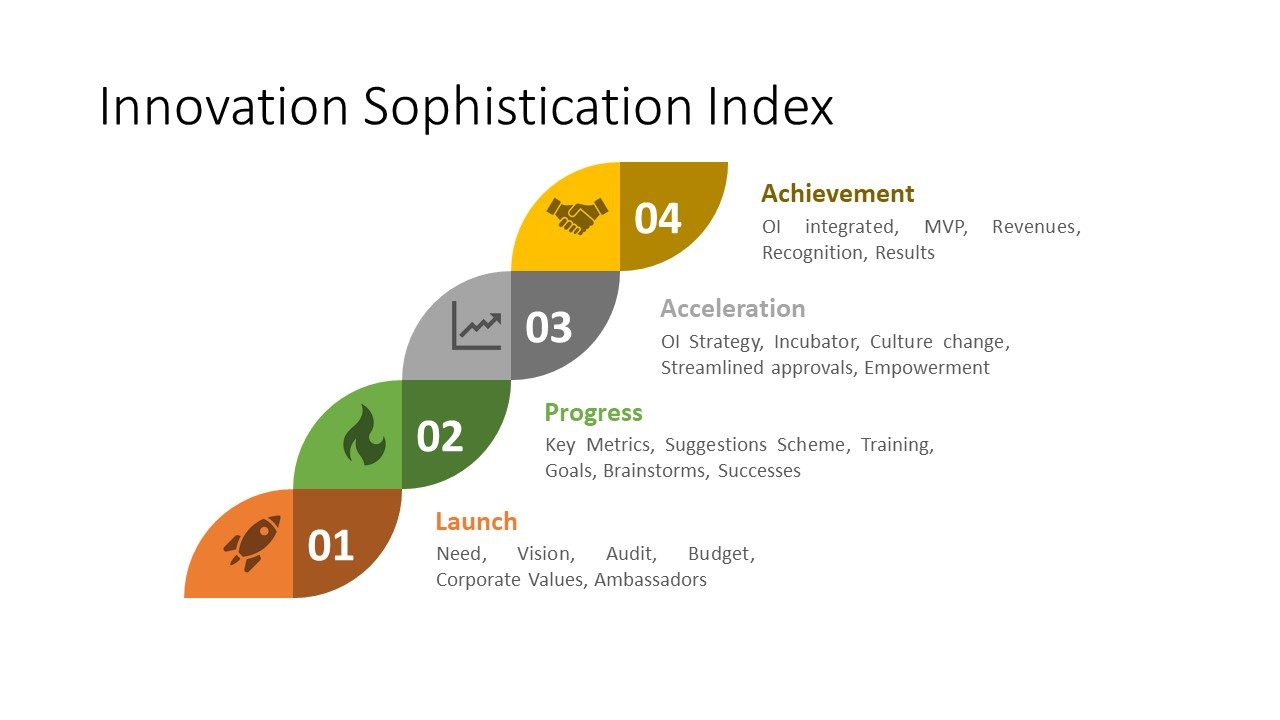Comments
- No comments found

How can you assess how innovative your business is?
The Innovation Sophistication Index is a list of just 24 statements. For each statement you score one point if you fully agree with it for your organization. Please try the list below now.

If your score is less than six then you are probably at Stage 1. This is the Launch phase where the need for innovation is recognised but not much has been achieved so far. Many public sector bodies and staid companies are at this stage. They believe that they need to be more innovative but are so busy meeting the needs of customers that they have not made innovation a priority not allocated the necessary resources and commitment to make it happen.
If you score between 7 and 12 you are most likely in Stage 2 – Progress. You are taking serious steps to change the corporate culture and practices in order to generate and implement more ideas. Most companies are probably at this level.
A result between 13 and 18 indicates that you are at Stage 3 – Acceleration. Things are really happening with innovation and you are starting to see real results and improvements in performance. You are implementing modern concepts of Open Innovation and the Minimum Viable Product. Innovation can now become a serious competitive advantage for you.
If you score over 18 then congratulations. You have reached Stage 4 – Achievement. You are in the Premier League and playing with the big boys. You are reaping the rewards, revenues and recognition that befits an innovation leader. This is where Apple, Google, Amazon and others appear. You are among the sophisticated innovation elite.
The Innovation Sophistication List of Statements
A. Launch
1. Leaders recognise and communicate the need for innovation.
2. There is an agreed vision statement for a better future.
3. You have carried out an innovation audit to assess the current barriers to innovation.
4. A budget is allocated for innovation training and initiatives.
5. Entrepreneurship, empowerment, diversity and risk taking are seen as core values in the desired corporate culture.
6. Innovation ambassadors are appointed in different departments to co-ordinate and stimulate innovation initiatives.
B. Progress
7. Targets are set for key metrics including number of ideas submitted and implemented and for revenue projected and achieved from innovation projects.
8. Training is carried out for the senior executive team and for innovation ambassadors.
9. An internal suggestions scheme is in place with adequate resources to evaluate ideas and implement the best.
10. Regular brainstorm meetings are held with diverse teams, clear objectives and expert facilitation. Resulting ideas are implemented.
11. Innovation goals are included in people’s objectives and appraisals.
12. Innovation successes are broadcast and celebrated.
C. Acceleration
13. An Open Innovation strategy is agreed and initiated.
14. An Innovation Incubator Unit is established.
15. Approval processes have been streamlined to speed implementation.
16. More than 2 suggestions/employee/year are implemented.
17. Blame culture has been replaced with openness and challenge.
18. The Minimum Viable Product concept is fully adopted.
D. Achievement
19. An Open Innovation program is fully implemented and integrated. A significant proportion of innovations originate from outside.
20. New products and services represent a major portion of revenues.
21. Employees are empowered to try new initiatives and they do so.
22. Risks are encouraged, failure is allowed and lessons shared.
23. More than 5 suggestions/employee/year are implemented.
24. You are recognised as an industry leader in innovation and as a dynamic and rewarding place to work.
Paul is a professional keynote conference speaker and expert facilitator on innovation and lateral thinking. He helps companies improve idea generation and creative leadership. His workshops transform innovation leadership skills and generate great ideas for business issues. His recent clients include Airbus, Microsoft, Unilever, Nike, Novartis and Swarovski. He has published 30 books on lateral thinking puzzles, innovation, leadership and problem solving (with over 2 million copies sold). He also acts as link presenter at conferences and facilitator at high level meetings such as a corporate advisory board. He has acted as host or MC at Awards Dinners. Previously, he was CEO of Monactive, VP International of MathSoft and UK MD of Ashton-Tate. He recently launched a series of podcast interviews entitled Insights from Successful People.
Leave your comments
Post comment as a guest